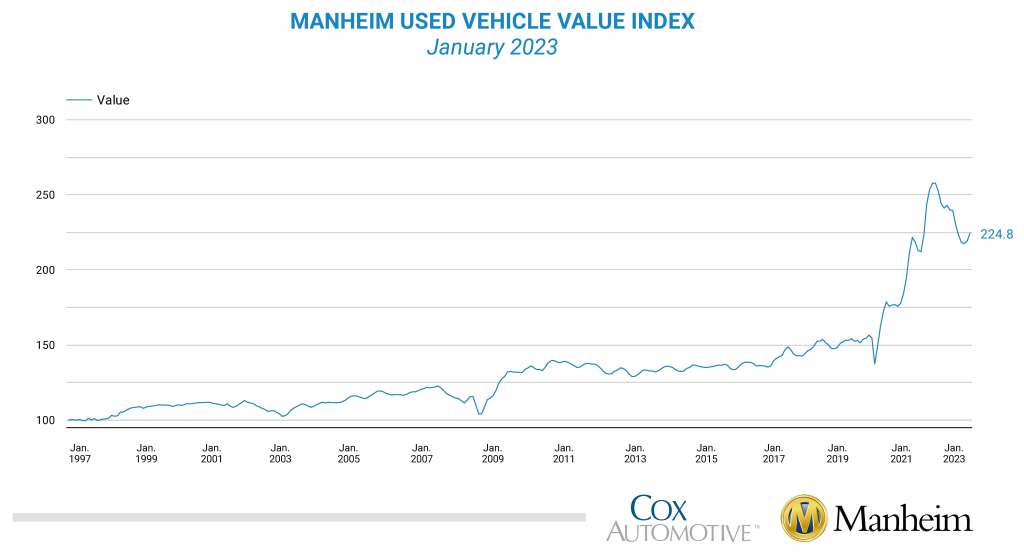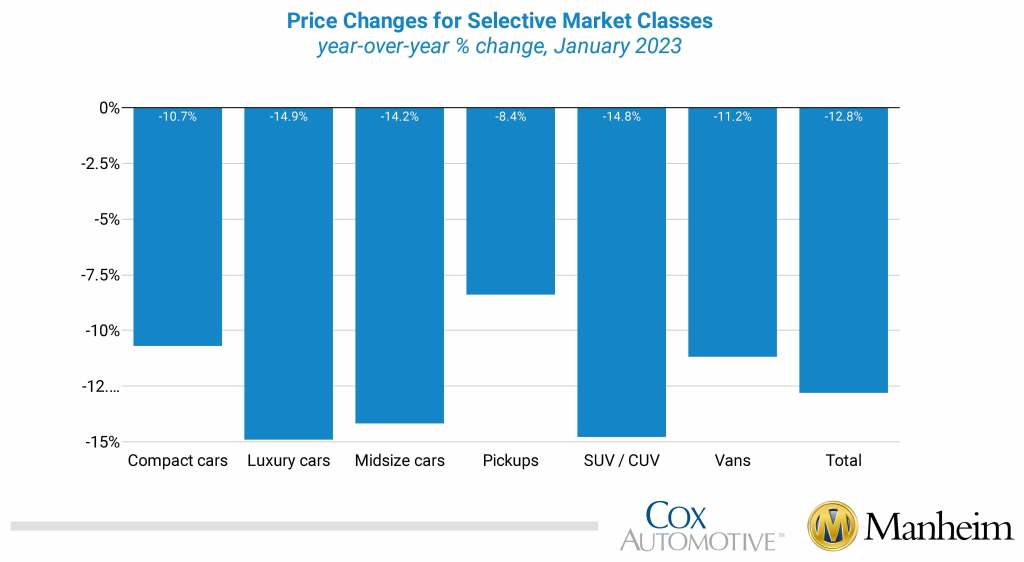Data Point
Wholesale Used-Vehicle Prices Increase in January
Tuesday February 7, 2023
Article Highlights
- Wholesale used-vehicle prices (on a mix, mileage, and seasonally adjusted basis) increased 2.5% in January compared to December.
- The Manheim Used Vehicle Value Index (MUVVI) rose to 224.8, down 12.8% from a year ago. January’s increase was driven in part by the seasonal adjustment.
- The non-adjusted price change in January was an increase of 1.5% compared to December, moving the unadjusted average price down 11.0% year over year.
Wholesale used-vehicle prices (on a mix, mileage, and seasonally adjusted basis) increased 2.5% in January compared to December. The Manheim Used Vehicle Value Index (MUVVI) rose to 224.8, down 12.8% from a year ago. January’s increase was driven in part by the seasonal adjustment. The non-adjusted price change in January was an increase of 1.5% compared to December, moving the unadjusted average price down 11.0% year over year.

In January, Manheim Market Report (MMR) values saw price increases that were not typical, culminating in a 1.2% total increase in the Three-Year-Old Index over the last four weeks. In January, MMR values are typically little changed. Over the month of January, daily MMR Retention, which is the average difference in price relative to the current MMR, averaged 99.9%, meaning market prices were very close to MMR values. The average daily sales conversion rate increased to 59.4% and was above normal for the time of year. For context, the daily sales conversion rate averaged 57.7% in January 2019. The higher conversion rate indicated that the month saw sellers with more pricing power than what is typically seen for this time of year.
All eight major market segments continued to see seasonally adjusted prices that were lower year over year in January. Pickups had the smallest decline at 8.4%, followed by compact cars, down 10.7%, and vans, down 11.2%. The other five segments’ prices were lower than the industry. Compared to December, six of the eight major segments’ performances were up between 0.8% and 3.6%, with pickups having the strongest showing. Only full-size and luxury cars were down compared to December.

Used Retail Vehicle Sales Increased in January
Leveraging a same-store set of dealerships selected to represent the country from Dealertrack, we initially estimate that used retail sales increased 16% in January from December and that used retail sales were up 5% year over year.
Using estimates of used retail days’ supply based on vAuto data, January ended at 44 days’ supply, down from 56 days at the end of December and six days lower than how January 2022 ended at 60 days. Leveraging Manheim sales and inventory data, wholesale supply is estimated to have ended January at 26 days, down six days from the end of December and down five days from how January 2022 ended at 31 days.
January’s total new-light-vehicle sales were up 4.2% year over year, with the same number of selling days as January 2022. By volume, January new-vehicle sales were down 18.6% from December. The January sales pace, or seasonally adjusted annual rate (SAAR), came in at 15.7 million, a 4.1% increase from last year’s 15.1 million and up 17.7% from December’s revised 13.4 million pace.
Combined sales into large rental, commercial, and government fleets were up 58% year over year in January. Sales into rental fleets were up 96% year over year, sales into commercial fleets were up 31%, and sales into government fleets were up 65%. Including an estimate for fleet deliveries into dealer and manufacturer channels, the remaining retail sales were estimated to be up 0.3%, leading to an estimated retail SAAR of 13.2 million, down 0.2 million from last year’s pace, but up 1.7 million from last month’s pace. The fleet share of 16.5% was up 3.3% from last year’s 13.2% share and was up 2.3% from last month’s 14.2% share.
Rental Risk Prices Mixed in January
The average price for rental risk units sold at auction in January was down 7.6% year over year. Rental risk prices were up 2.8% compared to December. Average mileage for rental risk units in January (at 55,800 miles) was down 5.9% compared to a year ago but up 0.2% from December.
Measures of Consumer Confidence Mixed in January
The Conference Board Consumer Confidence Index® declined 1.7% in January, as views of present situation improved but future expectations fell by 6.7%. Plans to purchase a vehicle in the next six months were unchanged from December and were down slightly year over year. The confidence index did not decline as much during the pandemic as the sentiment index from the University of Michigan, but that series improved in January. The Michigan index increased 8.7%, driven primarily by improvement in the view of current conditions, which was up 15.2%. Consumers’ views of buying conditions for vehicles improved to the best level since July 2021. The daily index of consumer sentiment from Morning Consult measured modestly declining sentiment in January, as that index declined 1.5% for the month. Sentiment declined in January as the price of gasoline increased. According to AAA, the national average price for unleaded gas increased 9% in January to $3.50 per gallon on Jan. 31, which was up 4% year over year.
The complete suite of monthly MUVVI data for February will be released on March 7, 2023, the fifth business day of the month, as regularly scheduled.
For questions or to request data, please email manheim.data@coxautoinc.com. If you want updates about the Manheim Used Vehicle Value Index, as well as direct invitations to the quarterly call sent to you, please sign up for our Cox Automotive newsletter and select Manheim Used Vehicle Value Index quarterly calls.
The Manheim Used Vehicle Value Index was adjusted to improve accuracy and consistency across the data set as of the January 2023 data release. The starting point for the MUVVI was adjusted from January 1995 to January 1997. The index was then recalculated with January 1997 = 100, whereas prior reports had 1995 as the baseline of 100. All monthly and yearly percent changes since January 2015 are identical. Read more about the decision to rebase the index and review the index methodology for more details.
